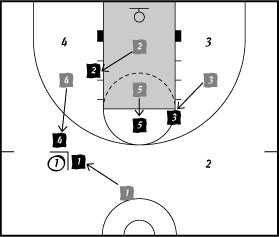Press is short for pressure. Often called a full-court press, this is an attacking defense employed in the backcourt, where the objective is to force a turnover. Usually used after a made basket, the pressing team swarms all over the opponents in the backcourt; if the opponents successfully get the ball past half-court (called breaking the press), the pressing team usually falls back into their normal defense. The strategy of the press is to force the ball handler to make a decision before he wants to.
Why press?
Pressing can help your team gain both an offensive and defensive advantage. These are instances when you'd want to press:
- The opponent has poor ball-handling ability. A poor ball handler is anyone who makes turnovers.
- To disrupt the opponent's offensive rhythm.
- To increase the tempo of the game. When playing against a slow, methodical team, if you can change the game pace with a press, your offense is more likely to get steals and easy baskets, which helps their confidence.
- Your players believe in it. Arkansas coach Nolan Richardson uses the term "40 Minutes of Hell" to describe playing his team. His players bought into the concept of pressing from start to finish — of turning the game into a war of attrition. If your players love to press and you have the bench depth to do it, pressing is a great way to play. Full-court pressure results in lots of turnovers and, hence, easy baskets. But pressing is also physically demanding and can tire players quickly.
- It's something different. Few hoops teams have the athletic ability and bench depth to press all game, hence most teams devote little practice time to breaking the press.
Figures 1 and 2 show two common press formations.


The trap press
This press uses the sideline as a third defender (shown in Figure 3).

The trap press involves three steps:
1. Trap the ball.
After your opponent in-bounds the ball, trap the player who receives the pass. Two players force him toward the sideline. Don't give the player with the ball an opportunity to look for an open teammate; attack the ball immediately.
2. Keep the player surrounded in the trap.
After the player with the ball puts the ball on the floor and begins her dribble, the defender in front of her must force her to the sideline. The inbounds pass defender approaches from behind to effect the trap.
When she picks up her dribble, she should reach in for the ball with two hands to make a pass. If you reach in, reach with one hand on top and the other on the bottom of the ball. If the opportunity to put two hands on the ball — to either steal it or get a held-ball call — is not there, don't risk it.
3. Anticipate the desperation pass.
But do not foul the trapped player.
Teach all your defensive players every spot on the floor in the trap defense so they get a feel for where everyone is supposed to be and they know when to make the interception. The players have more confidence in what their teammates are doing, and you can sub each player in for anyone during a game.




